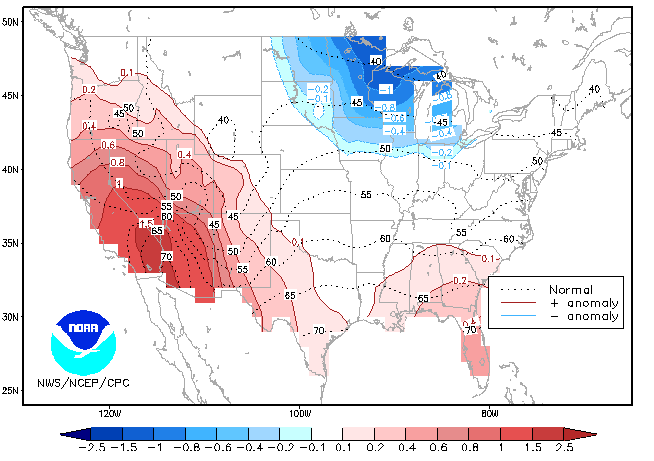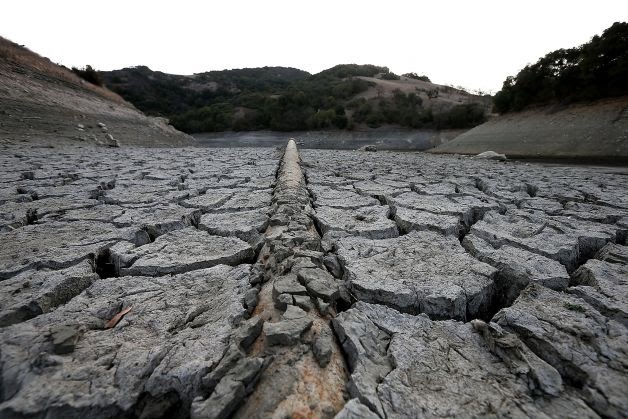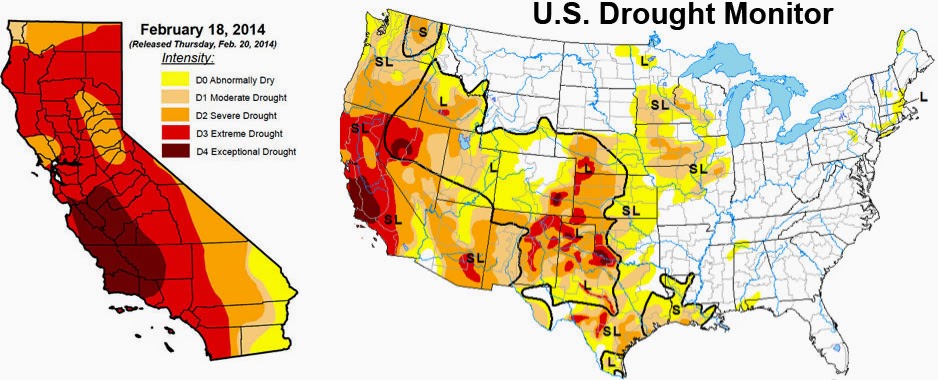How to Beat Coming Killer Food Shortages
50% of America's fruits and veggies are grown in California and the Feds are destroying their crops. What this means for you.

Full NOAA maps HERE
Holly Deyo
Activist Post
PREFACE: Only a small space is required to grow most fruits and veggies for a family. So Stan and I will scamper over to our local garden center this week and for additional organic compost to augment our Super Soil and get those growies growing! By the end of Summer our own compost piles should be ready to sustain the gardens hereafter. It just takes a little while to get there.
Sunday, we planned out this year's garden – including more than usual. Definitely making time for canning this year. Had the equipment, not the time. Since warmth – and dry (drat!) – are coming early this year to the West, Southwest and Southeast, it's important to get our garden ready in February and seedlings sprouted and sunk in the ground by late March instead of late April – a full month ahead of normal. The most time-consuming aspect will getting the Super Soil pre-warmed as described in Garden Gold, which will only require a couple hours, so plants get a head start and beat this Summer's killing heat.
These NOAA maps show the probability of temperatures exceeding the norm, so roughly 1/3 of the Country can get their veggies and fruits in early. Unfortunately, as 2014 progresses, a bunch of us will be sweating bullets living in tank tops and shorts.
Click on the different NOAA 3-month outlooks (under More POE Outlooks) on the left to see how temps are revving up hotter and earlier this year. It's weird that after this blisteringly bitter cold winter, we have to think in terms of excessive heat, but that's what extreme climate change is about and something Stan and I have warned would descend since 1995. Now that it's here, everyone must act with fore-thought and planning. With what's coming, every day counts. —Holly
TAN DROUGHT KILLING THE GOLDEN STATE
Government has lost its mind. It is no more evident than their decision last week to cut off water to America's food basket. Squeezed by the worst-ever drought in the state's history, California is dying of thirst. Crushing news was delivered to farmers that no water would be coming from the Federal government. This dreaded decision was compounded by the Sierra Mountains getting just 25% of normal snowpack. There is no water to replenish already dangerously low reservoirs.

Photo: A pipe emerges from dried and cracked earth that used to be the bottom of the Almaden Reservoir on January 28, 2014 in San Jose, California. Now in its third straight year of drought conditions, California is experiencing its driest year on record, dating back 119 years, and reservoirs throughout the state have low water levels. Santa Clara County reservoirs are at 3% of capacity or lower. (Justin Sullivan, Getty Images)
Despite recent storms, it's done nothing to alleviate the staggering dryness. California needs snow. Desperately. Down bursts can't soak into parched, concrete-like soil so it rolls off, unused, into sewers and drainage ditches. Snowpack melts slowly and is easily funneled into reservoirs and sinks into land and eventually groundwater basins.
Gov. Jerry Brown declared a drought emergency 5 weeks ago and conditions have worsened since.
Farmers who thought this might be coming delayed planting crops. Some have given up altogether. Even late harvests, where possible, would be better than wasting the cost of fuel to run equipment, paying farm workers to work dying fields, paying for seeds that likely won't survive summer – and have it all come to nothing. Over half a million acres won't even be planted.
Not that anyone wants a business penalized, but golf courses will be allowed to waste water in the most extravagant method possible. What would you rather have: food on the table or 225,000 acres of lush golf links? The amount of water required to keep them verdant is staggering. Residential customers are already being warned to conserve and some cities have passed mandatory water restrictions. The San Francisco Chronicle reports that 17 communities are at risk of running dry.
Image: It's clear from the image below that regions of California worst hit and in danger of running out of water are the prime food growing areas.
http://www.activistpost.com/2014/02/how-to-beat-coming-killer-food-shortages.html
50% of America's fruits and veggies are grown in California and the Feds are destroying their crops. What this means for you.

Full NOAA maps HERE
Holly Deyo
Activist Post
PREFACE: Only a small space is required to grow most fruits and veggies for a family. So Stan and I will scamper over to our local garden center this week and for additional organic compost to augment our Super Soil and get those growies growing! By the end of Summer our own compost piles should be ready to sustain the gardens hereafter. It just takes a little while to get there.
Sunday, we planned out this year's garden – including more than usual. Definitely making time for canning this year. Had the equipment, not the time. Since warmth – and dry (drat!) – are coming early this year to the West, Southwest and Southeast, it's important to get our garden ready in February and seedlings sprouted and sunk in the ground by late March instead of late April – a full month ahead of normal. The most time-consuming aspect will getting the Super Soil pre-warmed as described in Garden Gold, which will only require a couple hours, so plants get a head start and beat this Summer's killing heat.
These NOAA maps show the probability of temperatures exceeding the norm, so roughly 1/3 of the Country can get their veggies and fruits in early. Unfortunately, as 2014 progresses, a bunch of us will be sweating bullets living in tank tops and shorts.
Click on the different NOAA 3-month outlooks (under More POE Outlooks) on the left to see how temps are revving up hotter and earlier this year. It's weird that after this blisteringly bitter cold winter, we have to think in terms of excessive heat, but that's what extreme climate change is about and something Stan and I have warned would descend since 1995. Now that it's here, everyone must act with fore-thought and planning. With what's coming, every day counts. —Holly
TAN DROUGHT KILLING THE GOLDEN STATE
Government has lost its mind. It is no more evident than their decision last week to cut off water to America's food basket. Squeezed by the worst-ever drought in the state's history, California is dying of thirst. Crushing news was delivered to farmers that no water would be coming from the Federal government. This dreaded decision was compounded by the Sierra Mountains getting just 25% of normal snowpack. There is no water to replenish already dangerously low reservoirs.

Photo: A pipe emerges from dried and cracked earth that used to be the bottom of the Almaden Reservoir on January 28, 2014 in San Jose, California. Now in its third straight year of drought conditions, California is experiencing its driest year on record, dating back 119 years, and reservoirs throughout the state have low water levels. Santa Clara County reservoirs are at 3% of capacity or lower. (Justin Sullivan, Getty Images)
Despite recent storms, it's done nothing to alleviate the staggering dryness. California needs snow. Desperately. Down bursts can't soak into parched, concrete-like soil so it rolls off, unused, into sewers and drainage ditches. Snowpack melts slowly and is easily funneled into reservoirs and sinks into land and eventually groundwater basins.
Gov. Jerry Brown declared a drought emergency 5 weeks ago and conditions have worsened since.
Farmers who thought this might be coming delayed planting crops. Some have given up altogether. Even late harvests, where possible, would be better than wasting the cost of fuel to run equipment, paying farm workers to work dying fields, paying for seeds that likely won't survive summer – and have it all come to nothing. Over half a million acres won't even be planted.
Not that anyone wants a business penalized, but golf courses will be allowed to waste water in the most extravagant method possible. What would you rather have: food on the table or 225,000 acres of lush golf links? The amount of water required to keep them verdant is staggering. Residential customers are already being warned to conserve and some cities have passed mandatory water restrictions. The San Francisco Chronicle reports that 17 communities are at risk of running dry.
Image: It's clear from the image below that regions of California worst hit and in danger of running out of water are the prime food growing areas.
http://www.activistpost.com/2014/02/how-to-beat-coming-killer-food-shortages.html










 People will turn on each other in a second in this type of crisis.
People will turn on each other in a second in this type of crisis.